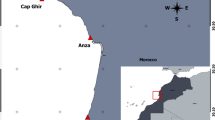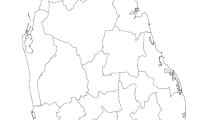Abstract
Caspian kutum, Rutilus kutum Kamensky 1901, is a commercially important fish species in the southern basins of the Caspian Sea. In spite of the popularity and consumption of the gonads, muscles, and viscera of kutum as edible parts in the region, there is no report on concentrations of trace elements (TE) in its gonads. In this study, some 51 specimens of R. kutum caught from five different fishing regions (Astara, Anzali, Kiashahr, Sari, and Gorgan) in the southern shoreline of the Caspian Sea from September 2017 to January 2018. An inductively coupled plasma optical emission spectrometry (ICP-OES) was used to assay 36 element concentrations in fish gonads, but only 26 elements were detected and statistically analyzed. The concentration of elements in gonads (except for Ca, Sn, and Sr) did not exhibit significant differences between the eastern and western parts (p < 0.05) of the Caspian Sea. The Ca and Sr concentrations were higher in western parts (Astara, Anzali, and Kiashahr) than in eastern parts (Sari and Gorgan), while Sn showed higher levels in eastern as compared to western parts. In total, the element concentrations in this study were not higher than thresholds permitted by FAO/WHO and USFDA and pose no threat to human health.




Similar content being viewed by others
References
Yari AR, Siboni MS, Hashemi S, Alizadeh M (2013) Removal of heavy metals from aqueous solutions by natural adsorbents (a review). Arch Hyg Sci 2(3):114–124
Janadeleh H, Kameli MA (2017) Metals contamination in sediment and their bioaccumulation in plants and three fish species from freshwater ecosystem. Toxin Rev 36(4):297–305. https://doi.org/10.1080/15569543.2017.1309551
Alipour H, Pourkhabbaz A, Hassanpour M (2016) Determination of metals (As, Cu, Fe, and Zn) in two fish species from the Miankaleh wetland. Arch Pol Fish 23:99–105. https://doi.org/10.1515/aopf-2016-0011
Jefferies DJ, Firestone P (1984) Chemical analysis of some coarse fish from a Suffolk River carried out as part of the preparation for the first release of captive-bred otters. J Otter Trust 1(18):17–22
Sen A, Semiz A (2007) Effects of metals and detergents on biotransformation and detoxification enzymes of leaping mullet (Liza saliens). Ecotoxicol Environ Saf 68:405–411
FAO/WHO (2018). General standard for contaminants and toxins in food and feed CXS 193-1995, amended in 2018
USFDA (1993) Food and drug administration. Guidance document for arsenic in shellfish. DHHS/PHS/FDA/CFSAN/Office of Seafood, Washington DC, p 1993
Sehonova P, Svobodova Z, Dolezelova P, Vosmerova P, Faggio C (2018) Effects of waterborne antidepressants on non-target animals living in the aquatic environment: a review. Sci Total Environ 631–632:789–794. https://doi.org/10.1016/j.scitotenv.2018.11.035
Rao LM, Padmaja G (2000) Bioaccumulation of heavy metals in M. cyprinoids from the harbor waters of Visakhapatnam. Bull Pure Appl Sci 19(2):77–85
Cid BP, Boia C, Pombo L, Rebelo E (2001) Determination of trace metals in fish species of the Rio de Aveiro (Portugal) by electrothermal atomic absorption spectrometry. Food Chem 75(1):93–100. https://doi.org/10.1016/S0308-8146(01)00184-4
Aladin N, Plotnikov I (2004) The Caspian Sea. Lake Basin Management Initiative
Karadede HL, Oymak SA, Unlu E (2004) Heavy metals in mullet, Liza abu, and catfish, Silurus triostegus, from the Ataturk Dam Lake (Euphrates), Turkey. Environ Int 30:183–188
Bibak M, Sattari M, Agharokh A, Tahmasebi S, Imanpour Namin J (2018) Assessing some heavy metals pollutions in sediments of the northern Persian Gulf (Bushehr province). Environ Health Eng Manag J 5(3):175–179. https://doi.org/10.15171/EHEM.2018.24
Sattari M, Namin JI, Bibak M, Vajargah MF, Hedayati A, Khosravi A, Mazareiy MH (2019) Morphological comparison of western and eastern populations of Caspian kutum, Rutilus kutum (Kamensky, 1901) (Cyprinidae) in the southern Caspian Sea. Int J Aquat Biol 6(4):242–247. https://doi.org/10.22034/ijab.v6i4.529
Anan Y, Kunito T, Tanabe S, Mitrofanov I, Aubrey DG (2005) Trace element accumulation in fishes collected from coastal waters of the Caspian Sea. Mar Pollut Bull 51:882–888. https://doi.org/10.1016/j.marpolbul.2005.06.038
Zar JH (1996) Biostatistical analysis, 3rd edn. Prentice Hall Inc, Upper Saddle River
Keouch Q (2002) Experimental design and data analysis for biologists. Cambridge University Press, Cambridge
Chi QQ, Zhu GW, Alan L (2007) Bioaccumulation of heavy metals in fishes from Taihu Lake, China. J Environ Sci 19:1500–1504. https://doi.org/10.1016/S1001-0742(07)60244-7
Roméo M, Siau Y, Sidoumou Z, Gnassia-Barelli M (1999) Heavy metal distribution in different fish species from the Mauritania coast. Sci Total Environ 232:169–175. https://doi.org/10.1016/S0048-9697(99)00099-6
Abdolahpur Monikh F, Peery S, Karami O, Hosseini M, Bastami AA, Ghasemi AF (2012) Distribution of metals in the tissues of benthic, Euryglossa orientalis and Cynoglossus arel, and bentho-pelagic, Johnius belangerii, fish from three Estuaries, Persian Gulf-Bull. Environ Contam Toxicol 89:489–494. https://doi.org/10.1007/s00128-012-0747-z
Krishnamurti AJ, Nair VR (1999) Concentration of metals in fishes from Thane and Bassein creeks of Bombay, India. Indian J Mar Sci 28:39–44
Mirzajani AR, Hamidian AH, Karami M (2016) Metal bioaccumulation in representative organisms from different trophic levels of the Caspian Sea. Iran J Fish Sci 15(3):1027–1043
Tabari S, Saeedi Saravi S, Bandany GA, Dehghan H, Shokrzadeh M (2010) Heavy metals (Zn, Pb, Cd and Cr) in fish, water and sediments sampled form Southern Caspian Sea, Iran. Toxicol Ind Health 26(10):649–656. https://doi.org/10.1177/0748233710377777
Malik N, Biswas AK, Qureshi TA, Borana K, Virha R (2010) Bioaccumulation of heavy metals in fish tissues of a freshwater lake of Bhopal. Environ Monit Assess 160:267–276. https://doi.org/10.1007/s10661-008-0693-8
USEPA (United States Environmental Protection Agency) (2015) Regional screening level (RSL) summary table, November (2015)
RDA (1989) Recommended dietary allowance, 10th edn. National Academic Press, Washington
Stancheva L, Makedonski K, Peycheva K (2014) Determination of heavy metal concentrations of most consumed fish species from Bulgarian Black Sea coast. Bulg Chem Commun 46(1):195–203
Bratakos MS, Lazos ES, Bratakos SM (2002) Chromium content of selected Greek foods. Sci Total Environ 290:47–58. https://doi.org/10.1016/S0048-9697(01)01057-9
Acknowledgements
This study was financially supported by The Caspian Basin Research Center, University of Guilan, Rasht, Iran, File Number 21195170.
Author information
Authors and Affiliations
Corresponding author
Ethics declarations
Conflict of interest
The authors declare that they have no conflict of interest.
Additional information
Publisher's Note
Springer Nature remains neutral with regard to jurisdictional claims in published maps and institutional affiliations.
Significance Statement The gonad of fish is used as food in Iran, and this study was proposed to investigate the trace element in gonads and to determine the accumulation of trace elements in it.
Rights and permissions
About this article
Cite this article
Sattari, M., Imanpour Namin, J., Bibak, M. et al. Determination of Trace Element Accumulation in Gonads of Rutilus kutum (Kamensky, 1901) from the South Caspian Sea Trace Element Contaminations in Gonads. Proc. Natl. Acad. Sci., India, Sect. B Biol. Sci. 90, 777–784 (2020). https://doi.org/10.1007/s40011-019-01150-5
Received:
Revised:
Accepted:
Published:
Issue Date:
DOI: https://doi.org/10.1007/s40011-019-01150-5




